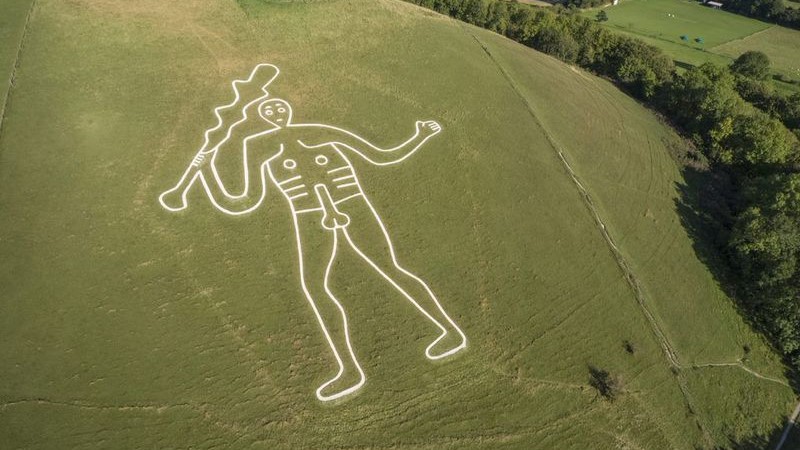Giant figure etched into English hillside could be 1,000-year-old portrait of a naked god
That's a large club.

Archaeologists are beginning to unravel the mystery surrounding a 180-foot (55 meters) naked giant figure that's carved in chalk on an English hillside.
Until now, scientists had assumed that the figure — brandishing a disproportionately large club — had been cut into a hillside in Dorset, southwest England, in prehistoric or Roman times (A.D. 43 to A.D. 410), or even in the 17th century.
But a new archaeological study by the U.K. National Trust has dated the so-called Cerne Abbas Giant to medieval times, or the the late Saxon period, possibly during the 10th century. It's a baffling discovery for scientists because the earliest known reference to the giant is from 1694, meaning that the enigmatic and hard-to-miss artwork had somehow been overlooked for centuries.
Related: 12 bizarre medieval trends
"This is not what was expected," Mike Allen, an independent geoarchaeologist, working with the National Trust on the study, said in a statement. "Many archaeologists and historians thought he was prehistoric or post-medieval, but not medieval. Everyone was wrong, and that makes these results even more exciting."
The researchers dated the giant by digging up samples of chalk from the soles of his feet and from his elbows; from those samples, they extracted quartz grains, which they analyzed using a technique called optically stimulated luminescence.
The technique takes advantage of the fact that once the quartz crystals get buried underground they are no longer directly exposed to sunlight. Instead, the crystals slowly absorb low levels of natural radiation from the soil and sediment that surrounds them; this so-called ionizing radiation excites electrons in the crystal lattice, a certain number of which become trapped in holes in the lattice structure. When these trapped electrons are stimulated by light again, they also give off light, shining brighter the longer the crystals have been absorbing the underground radiation. By measuring this brightness, scientists are able to calculate when the crystal was first deposited and buried.
Get the world’s most fascinating discoveries delivered straight to your inbox.
The discovery has rekindled the fire of a long-simmering debate among archaeologists and historians on the possible meaning of the giant, with rival theories placing the carving in nearly every period of English history — including ideas suggesting the figure represented Hercules or a 17th-century parody of the English statesman Oliver Cromwell.
The date range revealed indicated byfrom the researchers' analysis, however, situates the chalk used for the carving firmly between A.D. 650 and A.D. 1310.
"This probable Saxon date places him in a dramatic part of Cerne history," Martin Papworth, a National Trust senior archaeologist, said in the statement. "Nearby Cerne Abbey was founded in 987 A.D., and some sources think the abbey was set up to convert the locals from the worship of an early Anglo Saxon god known as 'Heil' or 'Helith'. The early part of our date range does invite the question, 'Was the giant originally a depiction of that god?'"
But this theory could be challenged by evidence that not every part of the giant is the same age. Further investigation from other samples taken from the site gave later dates of up to A.D. 1560, and Allen unearthed microscopic snails in the sediment samples belonging to species not introduced to Britain until the late medieval period, during the 13th and 14th centuries, which began the late fifth century. This seems to suggest that the giant was rediscovered and re-cut at a later stage, according to the researchers. But given that there is no archaeological evidence of him being covered over, how could he have gone missing for so long?
"It could have easily gotten quite overgrown," Timothy Darvill, an archaeologist at Bournemouth University in England, who was not involved in the study, told Live Science. "Once you've cut a trench and packed it with chalk, it doesn't need much maintenance to stay the way it looks today. But the soil around it can easily get covered in grass, shrubs and bushes. This is what could have hidden the giant."
This process of being covered and uncovered, possibly multiple times, could have led to many iconographical changes to the giant, including the later addition of one of its most prominent features: its erect penis.
"When they were tidying him up, they could have added a little bit here or there," Darvill said.
The addition of the 26-foot-long (8 m) phallus, which most archaeologists agree was likely a more recent inclusion — and has been shown to have grown over time, according to a study in the journal Antiquity — gave the giant a 20th-century reputation for boosting fertility.
"When we made a program on the giant for TV, lots of people came forward claiming that they were conceived on it," Darvill said, referring to a public debate filmed for the BBC called ‘The Cerne Giant: An Antiquity on Trial’. "I don't know if there are many verifiable means of establishing that."
The researchers now hope to narrow down the date range for the figure's creation, as well as find out more about how the giant has changed over time. Archaeologists are also considering performing similar analyses on England's two other surviving ancient hill figures: the Long Man of Wilmington and the Uffington White Horse.
Originally published on Live Science.

Ben Turner is a U.K. based writer and editor at Live Science. He covers physics and astronomy, tech and climate change. He graduated from University College London with a degree in particle physics before training as a journalist. When he's not writing, Ben enjoys reading literature, playing the guitar and embarrassing himself with chess.


